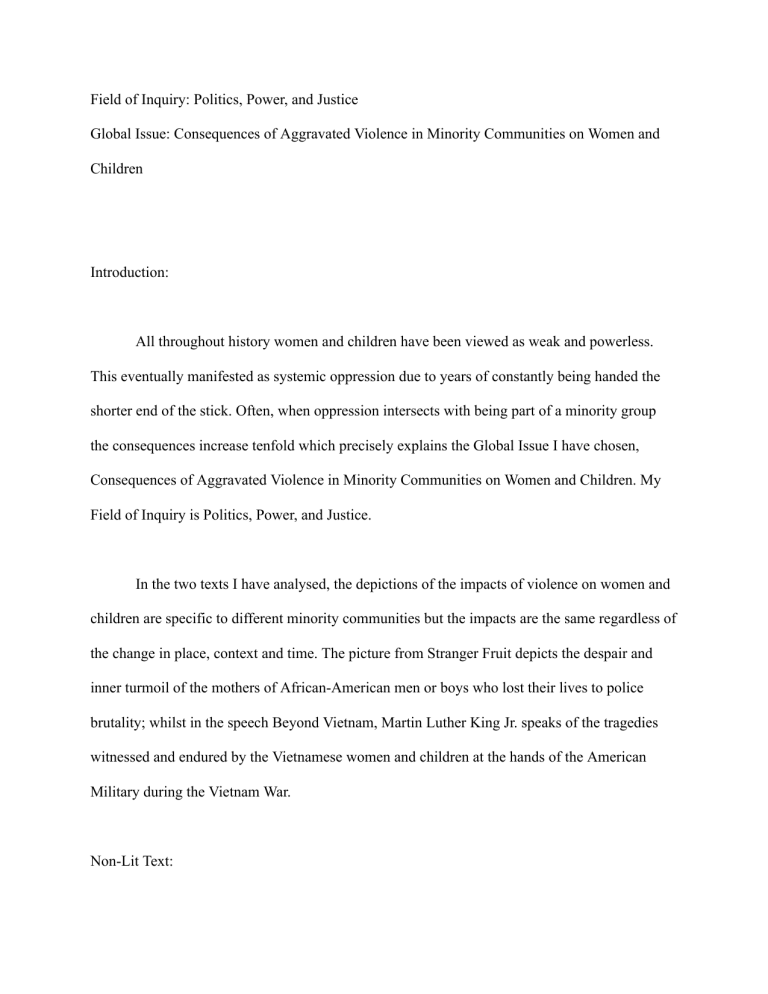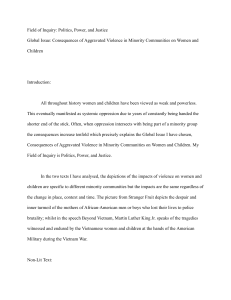
Field of Inquiry: Politics, Power, and Justice Global Issue: Consequences of Aggravated Violence in Minority Communities on Women and Children Introduction: All throughout history women and children have been viewed as weak and powerless. This eventually manifested as systemic oppression due to years of constantly being handed the shorter end of the stick. Often, when oppression intersects with being part of a minority group the consequences increase tenfold which precisely explains the Global Issue I have chosen, Consequences of Aggravated Violence in Minority Communities on Women and Children. My Field of Inquiry is Politics, Power, and Justice. In the two texts I have analysed, the depictions of the impacts of violence on women and children are specific to different minority communities but the impacts are the same regardless of the change in place, context and time. The picture from Stranger Fruit depicts the despair and inner turmoil of the mothers of African-American men or boys who lost their lives to police brutality; whilst in the speech Beyond Vietnam, Martin Luther King Jr. speaks of the tragedies witnessed and endured by the Vietnamese women and children at the hands of the American Military during the Vietnam War. Non-Lit Text: Stranger Fruit is a collection of photographs by John Henry, that depict a black mother’s despair of losing her son as a victim of police brutality. The title itself is inspired by the poem “Strange Fruit” which was written as a protest against the lynching of African Americans by comparing the victims to the fruit of the tree. In the picture that I have chosen, a woman can be seen waiting near a railing and staring out into space. This is one of the only pictures in the collection that only features a woman and does not include a man in the picture. Henry shoots the image at eye level while pointing the camera directly at her, making her the main subject and blurring the surrounding completely. This could represent her isolation from the rest of the world as well as a mental block due to the possibly traumatic experience. The woman appears disconnected and lonesome as if she is the only person in the world due to the angle at which the photo was taken, which draws the viewer's eyes directly to her. The way that the photo was taken captures the inner anguish and grief of a mother. Since the image only consists of cool tones and lacks warmth and saturation, which are typically associated with happiness, this could also be interpreted as a representation of the subject's inner agony. Additionally, she is dressed entirely in black and no light is falling on her, which contrasts with the colours in the background and could be interpreted as a representation of the disparity between the woman and the outside world. Henry might be alluding to the alienation and apathy of the black community because their views are not taken seriously. To contradict that depiction, Henry adds no details to the background of the image and only emphasises the woman's human form, giving both the image and the subject an additional dimension. This humanises her and differentiates her from the one-tone objects in the background. The image resonates with the global issue because it focuses on a mother and the consequences that she has to deal with due to police brutality. There is no child in the picture but her powerlessness and grief are depicted through her lack of facial expressions and hunched shoulders that seem like those of someone who has lost all hope and is only left with despair. The manifestations of community violence on a woman who was not even involved perfectly showcase the lives of individuals without power because they cannot do anything other than grieve. This is what Henry does in the rest of the collection's images as well. The use of a film camera, which only captures cool tones and lacks warmth, might also be regarded as a deliberate decision to emphasise how long racism has persisted. The woman in the other image I chose is in has no light on her and is wearing black clothing, but the official government building has direct sunshine shining down on it, putting the responsibility on the authorities rather than the women and children who are the easy targets. In that image, the mother and her children are also by themselves, illustrating the lack of empathy for the black community because violence against them has become so commonplace and they do not receive justice for it. Lit Text: In Martin Luther King Jr.’s speech, Beyond Vietnam, there is a section where he mentions all the atrocities that women and children have had to go through at the hands of the American troops during the Vietnam War. He initially starts that part by referring to women and children as a group of people who have no choice but to move on since they are not typically at the forefront of the war. He lists out various things that Vietnamese women and children must do as a result of military operations.in order to highlight the gruesome things from their perspective as well as help the audience comprehend the magnitude of the atrocities. By listing everything that ‘they’ had seen or done from Line 1 to Line 7, King emphasises all of the traumatic experiences and consequences that women and children had to endure without physically being involved in the war. After that, King explicitly states that most children were killed in order to garner a stronger reaction from the audience since children are viewed as symbols of joy and innocence. He uses this as a persuasive technique to appeal to the audience's sense of morality and righteousness by hinting that the Americans were stripping the Vietnamese of their innocence and joy. In Line 7, he uses a simile to compare children to a pack of animals thus dehumanising them and ripping away their innocence in the same way violence does. Similarly in Line 8, the speaks of children selling their sisters. In stable families, children normally do not have that kind of authority but in the state of war, they must make decisions in order to survive. By referring to this MLK implicitly suggests how wars taint childhood. He also specifies sisters since only women are demanded and sold to soldiers like objects highlighting the differential treatment of men and women. He asks rhetorical questions in order to make the audience think while guiding them towards the conclusions he wants them to reach. For example, in Line 12 he asks if the new Vietnam can be built among the voiceless ones. He refers to women and children as voiceless ones because they lack power and their opinions aren't considered worthwhile. King refers to them as such since they are institutionally oppressed and the destabilisation only adds to it. He also draws on irony when arguing that the Americans had corrupted women and children which juxtaposes the very goal of the war, to “liberate” Vietnam. MLK uses particularly strong language like degraded and destroyed to create a tone of indignation which results in the audience being left with a frustrated mood at all the atrocities. However, contradictory to his points, King says the phrase “our new Vietnam” in Line 20, taking away autonomy from the Vietnamese, especially the women and children who already lack it. Finally, at the very end of the section, MLK asks his audience to speak for the Vietnamese since they are “brothers” but does not refer to women or children since they are not technically at the front lines of the war. This discounts all the trauma that they have to endure since it is not acknowledged or compensated as victims. Martin Luther King Jr. used similar structures in his other speeches as well. In a Eulogy to Dead Children, he also repeats the phrase “they have” and lists various things the children have done or endured in order to place emphasis on the heinous acts. He also refers to children as “unoffending, innocent, and beautiful”. Similarly in the speech he gave at the mass meeting at Holt Street Baptist Church, He introduces Rosa Parks as a fine citizen and Christian lady but does not mention Fred Daniel until the end. He says a lady would be given a seat by a gentleman but Parks was not viewed as a woman which is a result of constant stereotypes that black women are not as feminine, but his King’s usage of women and and children as political tools is blatantly obvious. Due to the fact that they are viewed as weak and oppressed, their stories are likely to elicit more sympathy and he uses this t as a persuasive tool to manipulate his audience. Conclusion: Understanding that women and children are oppressed by the patriarchal system, which denies them the same authority as males, is essential. As a result, they will experience additional negative effects on top of those that men would experience. This is a timeless issue that persists today during the Black Lives Matter Movement of during The Civil Rights Movement. It also persists across borders to various minorities such as racial or ethnic ones, like the Vietnamese, or other such minorities. The intersectionality of inequality is a complex issue but specifically, women and children who belong to other minority groups have it worse.

![vietnam[1].](http://s2.studylib.net/store/data/005329784_1-42b2e9fc4f7c73463c31fd4de82c4fa3-300x300.png)



